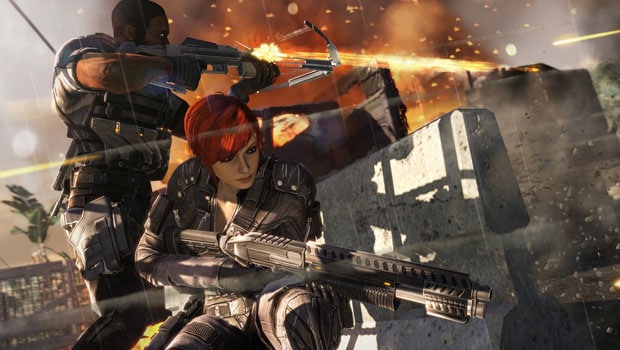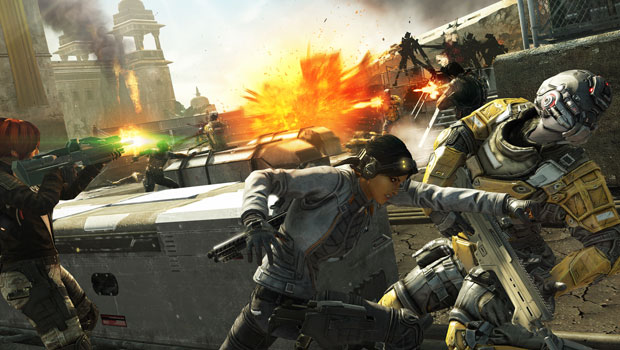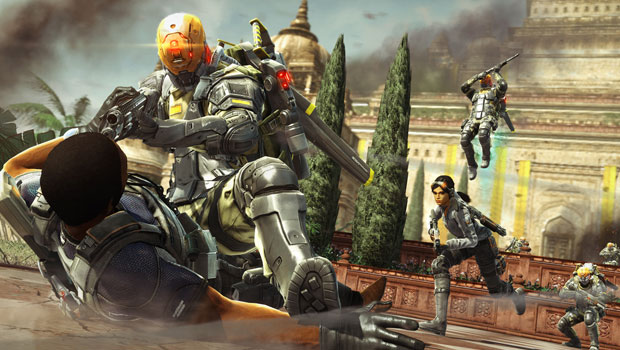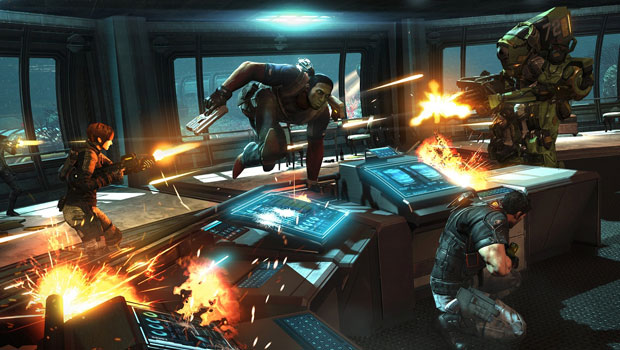It’s hard to play Fuse and not wonder what Insomniac was thinking during its development. Striking out on their own after years of Sony exclusivity would have made for the perfect opportunity to show their best side off to a sizable non-PlayStation owning populace. They may have been over-shadowed at Sony by the sheer brilliance of fellow old-timers Naughty Dog and Studio Santa Monica, but the Ratchet & Clank games have been consistent enough in their quality, and the Resistance series ended with the under-appreciated swan song that was Resistance 3 – a fittingly nihilistic look at humanity’s future.
Perhaps this new release is just a middling game – an aberration unworthy of over-analysis, or perhaps Resistance 3 sucked what was left out of the developer at the end of an almost two decade long courtship. Either way, there’s no mistaking the creative bankruptcy that fueled Fuse. Coming at a time when the videogame industry is struggling to figure out a place for itself in a rejigged entertainment landscape, Insomniac’s latest sadly doesn’t do the bare minimum needed to stand out in an increasingly crowded (and hostile) marketplace.
The worst (and probably the saddest) part about Fuse is that you’ll want to struggle through its mediocrity hoping for it to get better – soon. It doesn’t. It does vary its level themes and its color palette is refreshingly broad, but the story goes nowhere, the characters are shamelessly cookie-cutter and the been-there, done-that combat never hits the high notes that Resistance or Ratchet & Clank did. Fuse is essentially a pop-and-shoot cover shooter where your only respite is that the combat isn’t broken. Pretty much the entirety of the experience consists of you and your squad shuffling between rooms and clearing them of enemies, interspersed with some hilariously droll climbing sequences. Uncharted or God of War, this is not.
The story revolves around a mysterious substance known as ‘Fuse’ that humanity stumbled on, and that’s now being exploited as an energy source. Early in the initial mission, you also find out that the top-secret underground bunker you’re in has also been weaponising the goop – surprise, surprise. And you and your squad-of-4 mercenaries for hire are caught in the midst of a turf war involving the government, PMCs, and evil terrorist empires. There’s not one interesting character in the bunch mind you, and as much as we’d like to blame EA for ‘nudging’ the look of the game a certain way, no way should that excuse the dire writing in the game or the laughable attempts at character building. You can still make a by-the-numbers shooter interesting enough no matter what the tone is.
Your squad of four (who you can hot-swap between) have an arsenal of standard firearms they can pick up and use, and also a Fuse-powered weapon each that goes some way in livening up the combat. A couple of the more interesting Fuse weapons include Naya’s warp rifle that lets you tag enemies with shots before they’re all consumed by multiple black holes, and Jacob’s explosive cross bow that liquefies enemies on impact. Interestingly, the fuse weapons also have effects when used with one another – shooting through Dalton’s Fuse shield gives you more XP for instance. It’s nice that it’s an option, but you’ll only really feel the system’s full effect in co-op play.
This ties into the game’s XP and Fuse Credits system, fuelling your upgrade path down a by-the-numbers skill tree that buffs random weapon and character abilities. There are also team perks that you can purchase that give a separate set of buffs as well. They’re (probably) good to have, but not key to finishing the game. It’s worth noting that you won’t be able to max-out or unlock everything in a single playthrough, so there’s some replay impetus there if you have a group of friends who’ve all bought the game and are looking to wring every ounce of value from it.
With a four-person squad, it shouldn’t be too surprising that there’s the option for co-op. This is, ideally, how Fuse should be played, although that doesn’t take into account the hassle of coordinating with three other friends to play through the whole game. You also have the option of matchmaking, but EA’s origin servers have been hit or miss most times. Play the game alone and the AI is guaranteed to fail you more than once. They don’t prioritise reviving you when you’re down, line dancing through gunfire until they’re all down and then, you have to deal with Fuse’s annoying spaced out checkpoints.
You’ll also see them stand around right next to enemies, shoot first when you want to stealth as many of the identikit baddies as you can, and generally not be very artificially intelligent. That isn’t to say they don’t pull their weight. There are also times when they draw fire away from you, letting you flank enemies, and generally being proactive during an encounter. Unfortunately all this is expected of a shooter in 2013, and it’s the egregious fails that stand out.
The only other mode worth mentioning is the Echelon mode, a variation on the now overused horde mode but with inconsequential objectives that your team needs to complete while surviving increasingly difficult waves of enemies. Playing this with a full-AI squad is just asking for trouble, as they’re just not up to the task.
Conclusion:
Given the developer pedigree behind Fuse, its sheer average-ness takes some time to sink in. What’s even more disappointing is that Fuse isn’t a broken game that you can write off and be done with, either. The gameplay mechanics are functional if not exactly enjoyable, but there won’t be a minute where you won’t wonder whether you could be doing something better with your time instead.








